Proper Way to Drink Good White Tequila Art of Manliness
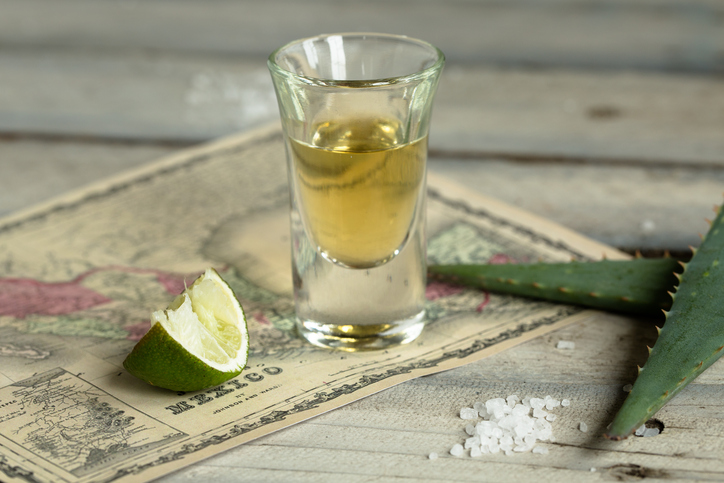
While tequila tends to have a poor reputation hither in the States — often serving as the cheap shot of option for inebriation-minded college students — in Mexico, it's a cultural tradition that harkens back to centuries of craftsmanship. While some liquors' origins are muddy or disputed, tequila is unquestionably a Mexican spirit.
While in shot form tequila is ordinarily served with salt and lime to mitigate the bite and burn of cheap liquor, in its native home information technology's usually served neat in a tall shot glass, and meant to be sipped.
If yous have an unfortunate history with tequila, information technology'southward fourth dimension you gave the spirit another run a risk and learned how to not only potable information technology the right way, but buy the correct product so that you aren't just writing off the whole category based on the swill that got you lot boozer in your earlier years.
Before getting into some of those guidelines though, we outset need to know what tequila is.
What Is Tequila?
Though slightly more complex than this when y'all get into the legalities of labeling and what non, tequila is really a specific type of mezcal. Mezcal is a distilled liquor made from the mashed, fermented core of the agave found. Tequila is then a mezcal made specifically from the blueish agave and in a specific role of Mexico.
Much like champagne — which tin legally just be made in the Champagne region of France — tequila can only be fabricated in a certain region of Mexico. Largely, this is in the state of Jalisco (where the boondocks of Tequila is located), equally well as parts of Guanajuato, Michoacán, Nayarit, and Tamaulipas. These states are in west-central Mexico, where the rich volcanic soil provides the perfect environment for growing blue agave.
What Is an Agave Constitute?
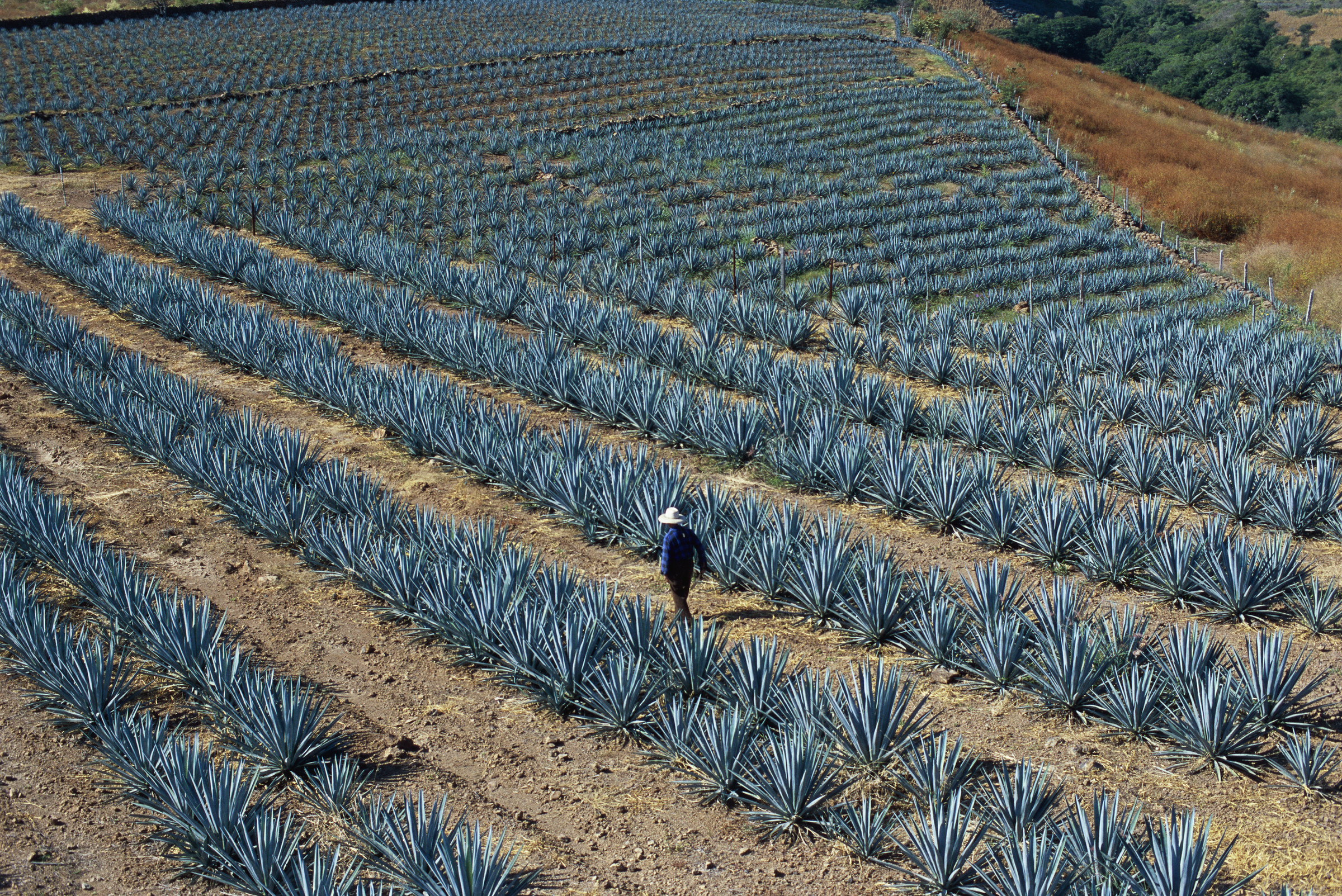
A field of blueish agave plants. Notice the calibration of the human being walking between rows. The leaves get to near man-superlative when matured.
Whereas rum relies on sugar cane/molasses, brandy on grapes, and whiskey on various grains, the agave is the lifeblood of tequila. To understand one, yous have to understand the other.
Agave is a large establish that looks similar a large head of spikes. Those spikes are its leaves, and the primary body — called a piña — is what'due south used to make tequila. Agaves are actually big . The piña can weigh 150-250 lbs at harvesting.
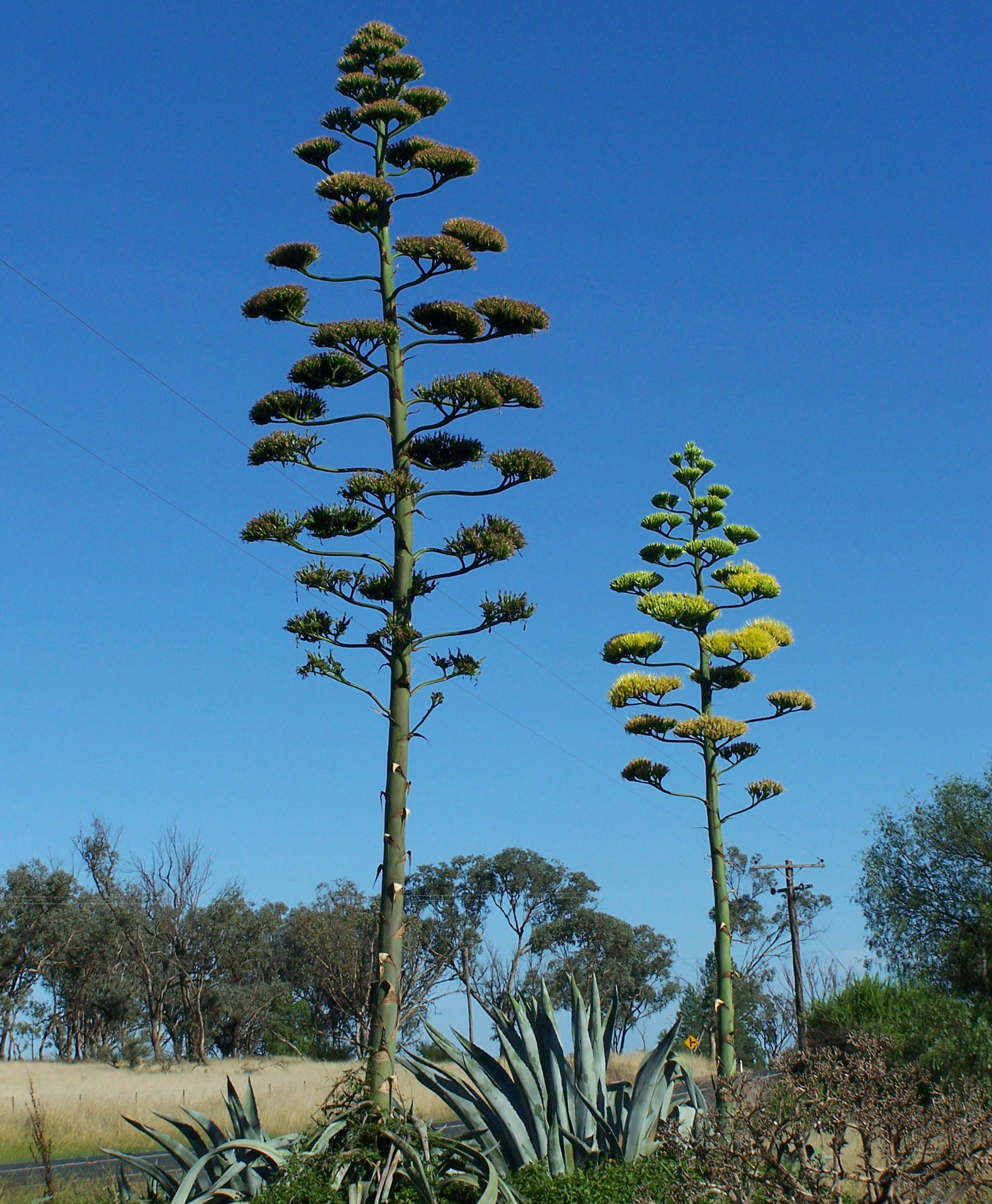
The tree-similar "bloom" of the agave. These are trimmed in tequila fields to extend the life of the found.
Specially trained farmers/harvesters trim the leaves and harvest the plants, and this process has largely been unmechanized. Agave is a fickle plant that takes 7+ years to mature, and it'south not a foolproof process. The plant has a flowering spike, which emerges from the middle only once (reaching tree-like heights), at which point the agave dies because that flower basically takes all its life support. But, farmers trim that flower to prolong the life of the plant, which is necessary for it to fully ripen and become mezcal/tequila prepare.
How Is Tequila Made?
After the piñas are harvested, they go into an oven for baking, afterward which they are functionally juiced, like a giant orange. The pulp is left behind, but the juice is nerveless, and from here the process looks much like it does for any other fermented/distilled beverage.
That juice sits in vats for a few days while it ferments, resulting in a depression-alcohol liquid called wort (beer aficionados should know that give-and-take). That wort is then distilled at least twice (which is a legal requirement of tequila), and sometimes a third time — though some purists say that this third distillation removes too much of the agave season (many brands put how many times their product'south been distilled right on the label for marketing purposes).
It'due south and then either bottled correct away or put into oak barrels to historic period.
How Tequila is Classified (or How to Read the Bottle)
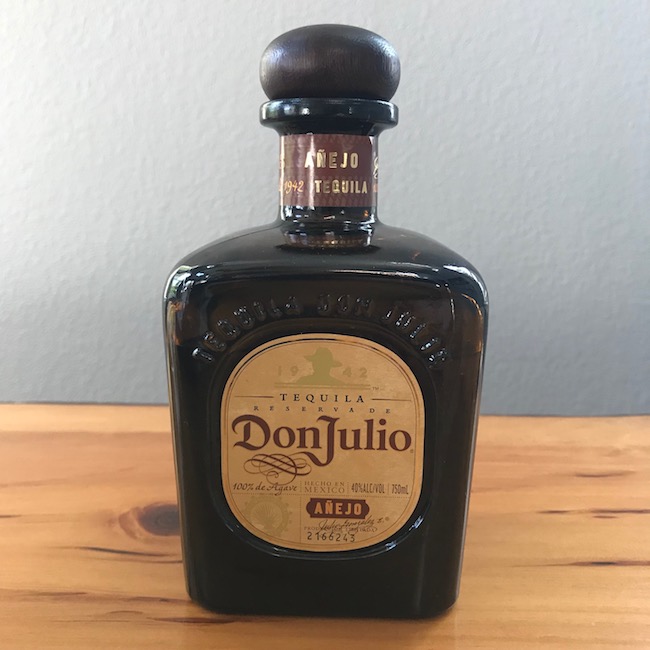
You lot'll notice all the information yous need to brand an informed choice right on the label. "Don Julio" is the brand. Right nether that, in smaller print, y'all'll see "100% de Agave." And you'll notice "Añejo" near the bottom.
When y'all're ownership tequila, there are a couple things to look for on the bottle that will help yous effigy out its contents.
The kickoff affair to cheque is whether it says something forth the lines of "100% agave" or "100% blue agave." According to Mexican laws (which govern tequila production, labeling, exporting, etc.), tequila only has to be made with 51% blue agave sugars in the fermentation procedure. The other 49% tin can exist other sugar sources, which is commonly cane. The tequilas that aren't 100% blue agave are called "mixtos." These tequilas won't exist marketed equally such — they just won't accept the "100% blue agave" anywhere on the label. It's brands on the inexpensive end of the spectrum that are mixtos, which is why they aren't trumpeting that fact. And even if it says "made with blue agave," if the "100%" isn't there, don't trust it. Remember, all tequila — for it to legally be labeled as such — has to exist fabricated with blue agave.
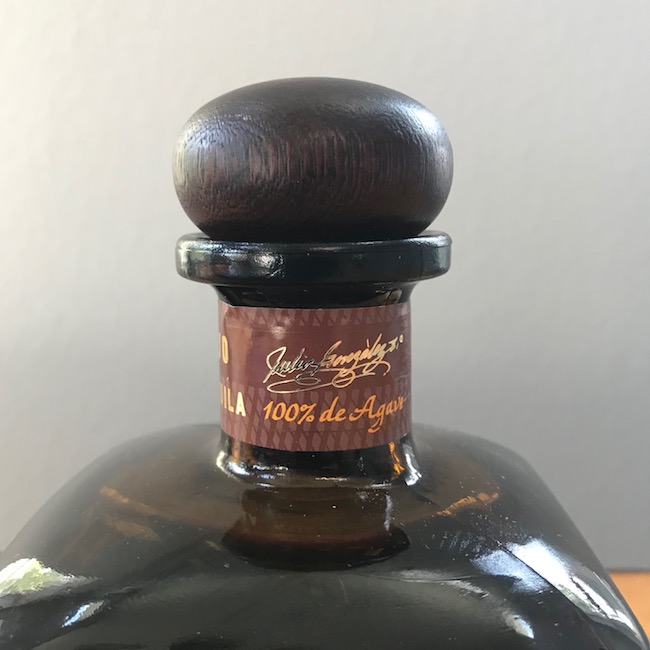
The "100% de agave" mark may also be on a cervix label.
Whatever of the crumbling monikers described beneath can be applied to either mixtos or 100% blue agave tequilas. Then first, look for this descriptor, which is usually in pocket-size print on the neck of the canteen or on the main label.
Next, you lot'll see i of the following crumbling labels, which is usually printed largely on the canteen. Yous tin can't miss information technology. I'd categorize tequila into three main varieties that you want to look for depending on what you lot like, and one depression-quality variety to avert.
Blanco/White/Silvery. This is the stuff that is bottled right after distilling, and is unaged. It'due south clear, and will be a proficient entry point into tequila. Since it'south not aged in wood barrels, some folks claim you become a more pure agave flavour, while others say information technology'southward more the vodka of the tequila world — lacking character. What you'll come to find is a thing of your ain taste. Regardless, this is what you lot'll near often use to make whatsoever sort of tequila cocktail. Proceed in mind that even though it's clear, it can however exist a loftier-quality, sippable product, just similar a white, unaged whiskey could be.
Anecdotally, people who really savour tequila like to sip the articulate stuff, whereas your whiskey fans oftentimes like the aged varieties ameliorate.
Reposado. This category of tequila has been anile for at least 2 months (usually in used bourbon barrels, but sometimes other spirits' barrels are used as well), but not exceeding a yr. Information technology'south a perfect middle-of-the-route tequila in terms of flavor profile. It'southward non overwhelming and still does well in mixed drinks, but can also be enjoyed as a sipper.
Añejo (or Extra Añejo). This is tequila that has been anile for at least 1 twelvemonth (or in the example of the "extra" diverseness, at least iii years). These are products that are indeed made for sipping rather than inclusion in cocktails. To use this in a mixed potable would exist like putting a fancy bourbon in a cocktail; much improve to sip and enjoy the fine product rather than muddle the flavor. Yous get a smooth, woody grapheme with these tequilas, which as alluded to higher up, is why whiskey fans will tend to like añejos.
Avert "Gold" or "Oro" tequila. This stuff is simply "gold" because information technology's had coloring added for the sake of looks. They are normally blends of blanco and reposado, but are always on the cheapo finish of the quality scale. Something like Cuervo Gold would be the example to stay away from.

One last case of label markings. All your most important data on a single line of text underneath the brand. You lot'll likewise notice "Triple Distilled" and "Highland Agave" at the bottom. ("Highland" refers to a specific region of tequila fields, much similar Scotland has regions for Scotch-making. Only true connoisseurs will be able to discern regional differences in tequila, dissimilar in Scotch where the different flavors are more than distinct.)
How to Drink Tequila
While tequila is often poured straight down the hatch, like whiskey, rum, and even expert gin, some tequilas can and should exist enjoyed neat or over ice with no garnishes or additional flavors needed. These will often be in the añejo category, but as mentioned, certainly not ever. Pour a couple ounces into a snifter-type glass, have some minor sips, letting it linger in the oral cavity, and savour. Pretty simple, actually.
That said, tequilas of all varieties lend themselves very well to citrus additions. Lose the common salt that you usually get when tequila is taken as a shot, but keep the lime. Pour a couple ounces, and squeeze some lime juice into the glass. For me, it really seems to burnish upwardly the tequila and also soften some of natural bite, making for a very nice complement.
And of course, the unique flavour of tequila does very well in summery cocktails, particularly the margarita. We'll start there. And while the number of classic tequila cocktails does not number very high, there are a couple others to effort out as well.
Classic Margarita
In that location are a million and one margarita opinions and variations. Below, y'all'll find a archetype margarita recipe that's so like shooting fish in a barrel y'all won't need to carp with the cheap margarita mixes that line liquor store shelves, or resort to drawing one from a frozen slushie motorcar.
The classic ratio is 3 parts tequila, 2 parts triple sec (or other orange liqueur, typically Cointreau), 1 part lime. That amounts to the measurements below, which can be scaled up or down according to your tastes:
- one.5 oz tequila (100% blue agave, blanco or reposado)
- ane oz triple sec or Cointreau
- .v oz juice of a lime
Shake with ice in a cocktail shaker. Cascade into a glass with a salted rim (moisten rim with lime wedge, then dip onto plate with salt — the coarse, kosher multifariousness rather than table common salt).
Paloma
While non near as popular as the margarita here in the states, in Mexico the paloma is rather ubiquitous. It's an easy, delicious drinkable, though, that should be enjoyed more widely.
- ii oz tequila (100% blue agave, blanco)
- 3 oz grapefruit juice (either fresh, or every bit ofttimes served in Mexico, in grapefruit soda form)
- Juice of lime wedge
- Dash of order soda (if using fresh juice rather than soda)
Shaken or stirred, and served in a salt-rimmed glass.
Tequila Sunrise
This drink gets its proper name from its characteristic look when served in a highball glass. It's been popular for about 75 years, ever since it was created in the American Southwest. Information technology became specially pop with rock bands in the '70s after Mick Jagger had one, and loved information technology and then much that he ordered information technology all over the state while on tour.
- i.v oz tequila (100% blue agave, blanco or reposado)
- 6 oz orange juice
- .five oz grenadine
- Orange piece, for garnish
- Maraschino ruby-red, for garnish
Fill a highball glass with ice. Add together tequila and orange juice and stir. Pour in grenadine, allowing it to sink to the lesser, creating the sunrise outcome. Garnish with an orange slice and maraschino cherry.
Tags: Vices
Previous Next
Source: https://www.artofmanliness.com/living/food-drink/a-mans-primer-on-tequila/
0 Response to "Proper Way to Drink Good White Tequila Art of Manliness"
Post a Comment